
Readington Township is a township located in the easternmost portion of Hunterdon County, in the U.S. state of New Jersey. As of the 2020 United States census, the township's population was 16,128, an increase of two people (+0.0%) from the 2010 census count of 16,126, which in turn reflected an increase of 323 (+2.0%) from the 15,803 counted in the 2000 census.
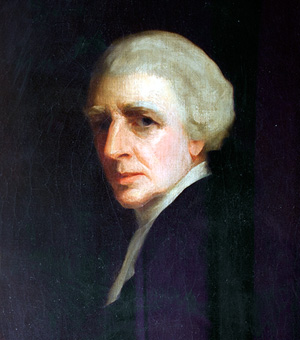
Jacob Rutsen Hardenbergh was an American Dutch Reformed clergyman, colonial and state legislator, and educator. Hardenbergh was a founder of Queen's College—now Rutgers, The State University of New Jersey—in 1766, and was later appointed as the college's first president.

Quakertown is an unincorporated community located within Franklin Township in Hunterdon County, New Jersey. It was once known as Fairview. The area was settled by Quakers from Burlington County, who organized a meeting house here in 1733. The Quakertown Historic District was listed on the state and national registers of historic places in 1990.

Norton is an unincorporated community located within Union Township, in Hunterdon County, New Jersey. Norton is located on County Route 635, approximately 1.5 mi (2.4 km) northwest of Interstate 78. The village is included in the Van Syckel Corner District, which was added to the National Register of Historic Places in 1979.

Fairmount is an unincorporated community located along County Route 517 in Tewksbury Township of Hunterdon County, New Jersey. The community was first known as Parkersville, named after proprietor James Parker (1725–1797). The southern section of the community is known as Lower Fairmount.
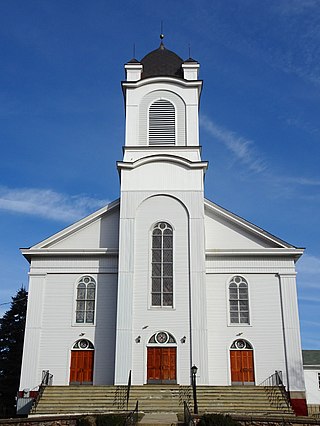
Readington Village is an unincorporated community located within Readington Township in Hunterdon County, in the U.S. state of New Jersey, that is centered on the converging of Readington Road, Hillcrest Road, Centerville Road and Brookview Road. It is located on Holland Brook, originally named Amanmechunk, which means large creek in the Unami dialect. The area was inhabited by the Raritan prior to the arrival of European settlers. The Native Americans who lived near Readington Village travelled to the coast during the summer for fish and clams. Such a trip is mentioned in an Indian deed transferring lands around Holland Brook to George Willocks, an East and West New Jersey Proprietor. The deed mentions two of the natives, who lived at Readington: Metamisco and Wataminian.
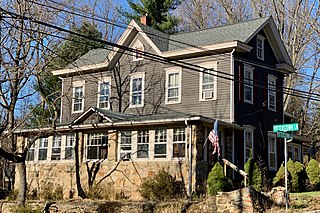
Potterstown is an unincorporated community along the border of Clinton and Readington townships in Hunterdon County, New Jersey.

New South Church (1714-1866) was a Congregational Unitarian church of the "New South Society" in Boston, Massachusetts, located on "Church Green" at the corner of Summer Street and Bedford Street. Pastors included Samuel Checkley and John Thornton Kirkland. In 1814 architect Charles Bulfinch designed a new building for the society; it was demolished in 1868. The congregation merged with the New South Free Church in 1866.

The Fairmount Historic District is a 409-acre (166 ha) historic district located along County Route 517 in the Fairmount section of Tewksbury Township, near Califon, in Hunterdon County, New Jersey. It was added to the National Register of Historic Places on December 20, 1996 for its significance in architecture, exploration/settlement, and industry. The district includes 72 contributing buildings that were deemed to be contributing to the historic character of the area, plus five contributing structures, nine contributing sites, and one contributing object. One contributing building is located in Washington Township, Morris County.

The Middlebush Village Historic District is a historic district located in the Village of Middlebush, an unincorporated community within Franklin Township, Somerset County, New Jersey. The district was added to the National Register of Historic Places on April 24, 2007. It includes 37 contributing buildings and three contributing sites.

Manahawkin Baptist Church, also known as the Free Church of Manahawkin, is a historic church in the Manahawkin section of Stafford Township in Ocean County, New Jersey. The church was added to the National Register of Historic Places on April 3, 1973, for its significance in education, military history, and religion.

The Six Mile Run Reformed Church is in the Six Mile Run section of Franklin Township, Somerset County, New Jersey. It takes its name from Six Mile Run, a tributary of the Millstone River that flows through the area.

Hiram Deats was an American businessman from Hunterdon County, New Jersey. He was known for manufacturing agricultural equipment, especially the Deats plow, and became the first millionaire in Hunterdon County.

The General John Frelinghuysen House is a historic building located in Raritan, New Jersey. The older west wing was originally a tavern, built sometime before 1756 by Cornelius Bogert, when it also served as the town's meeting hall. It was bought in 1801 by John Frelinghuysen and then came to be known as the Frelinghuysen Homestead. It is an excellent example of early 19th century Federal architecture in New Jersey. In 1975, it was donated by Peter Frelinghuysen, Jr. to the borough and now serves as the Raritan Public Library.

Cloverhill is an unincorporated community located at the intersection of the boundaries of East Amwell and Raritan townships in Hunterdon County and Hillsborough Township in Somerset County, in the U.S. state of New Jersey. The Clover Hill Historic District was listed on the state and national registers of historic places in 1980.

Lower Valley is an unincorporated community located along County Route 513 in Califon Borough and Lebanon Township of Hunterdon County, New Jersey. It is at the western end of Long Valley, historically known as German Valley, the valley of the South Branch Raritan River south of Schooley's Mountain.
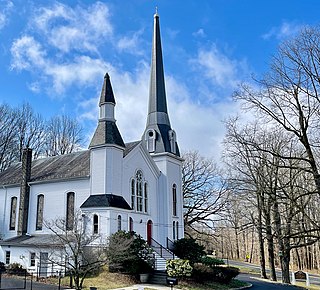
Spruce Run is an unincorporated community located along County Route 628 and Spruce Run Road within Lebanon Township in Hunterdon County, New Jersey. It is about 1 mile (1.6 km) northwest of Glen Gardner.

The North Branch Reformed Church is a historic church located on the eastern side of the North Branch of the Raritan River in North Branch, New Jersey at 203 New Jersey Route 28. It was formed by expansion from the Readington Reformed Church. The church was organized on September 10, 1825. The first church was built in 1826 and later rebuilt in 1874.

Spruce Run Evangelical Lutheran Zion Church, also known as Spruce Run Lutheran Church, is located at 442 West Hill Road in the Spruce Run section of Lebanon Township in Hunterdon County, New Jersey. The congregation is a member of the New Jersey Synod and the Evangelical Lutheran Church in America (ELCA).
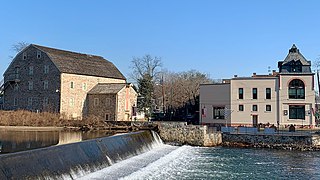
The Clinton Historic District is a 175-acre (71 ha) historic district encompassing much of the town of Clinton in Hunterdon County, New Jersey. It was added to the National Register of Historic Places on September 28, 1995, for its significance in architecture, commerce, engineering, industry and exploration/settlement. The district includes 270 contributing buildings, one contributing structure, and three contributing sites. Five were previously listed on the NRHP individually: Dunham's Mill, M. C. Mulligan & Sons Quarry, Music Hall, Old Grandin Library, and Red Mill.
























